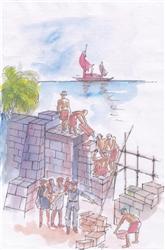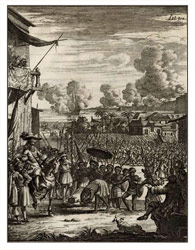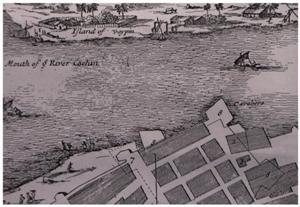The Dutch captured the encampments of the Portuguese one by one.
Quilon and Cranganore were captured.
The Portuguese continued to decline.

1661
The Dutch Captured Cranganore; Cochin Next Target
In Europe, the French, the English and the Portuguese all were against the Dutch. They started thinking over to weaken the Dutch power at any cost. At that time the Dutch fleet were moving on aiming at Malabar.
The Company appointed Vander Meydon, the governor of Ceylon to attack Malabar.
On 10 February 1661 he landed at Azheekode and seized Pallippuram Fort (Aayakkotta) from the Portuguese while they withdrew to Valiyakotta. But when they got additional military help they repulsed the attack and recaptured the lost possession and Vander Meydon returned without any gains. The Dutch, then, prepared new plans to renew aggression moving to north from Cape Comerin and attack Quilon, Cochin, Cranganore and Pallipuram. Van Goens was given the responsibility in carrying out this attack. All the Dutch forces in the east were instructed to participate in the offence.

When Nieuhoff, the captain of the Dutch ship, landed at Pulicat from Nagapatnam to purchase goods needed at Batavia, a small ship from Malabar reached there with a message. The content of the message was that fleets and fighters from Holland were waiting at the high seas and that he should return to Malabar cancelling all other engagements. All the goods purchased for transporting Batavia were brought down ashore and he returned to Quilon along with the fleet. The Nair chieftains and the Dutch forces armed with heavy cannons came into conflict when many died fired at by the Dutch. The Dutch confiscated the arms inside the forts. Then the Dutch force held a victory march through the town when they were fired at from the small forts. But the Dutch forces moved ahead heroically. They conquered the fort constructed by the Portuguese Captain Rodrigues and replaced the Portuguese flag.

the Nair's of Kollam
They moved ahead causing damage and destruction throughout their way scaring off people. The brass roof of a temple at Marthendaswaram (Matta del Reyne) became a globe of fire when the troops set afire to the gunpowder kept inside it. Frightened people ran helter skelter. After the passage of days the representatives of people came with request of peace. And thus Quilon, once lost, got back to them again. This victory gave the Dutch the courage to attack Cochin. With 11 ships Van Goens went to Cranganore. More ships later joined the fleet. Of them three ships were retained at Cochin. In January 1662, the Dutch group landed at Azhikode where the Zamorin waited for them along with the Raja of Cochin. Despite the Portuguese attack, the Dutch group, quite cleverly, reached ashore. They had already brought the guns and cannons through boats at proper destinations. Among the weapons were two brass cannons. They all of a sudden made war preparations, their strategy being lay siege the enemy both from land and sea. The guns of the Portuguese rattled relentlessly and the bullets from them killed many a Dutch soldier. Some Dutch soldiers impersonated themselves as the Portuguese and clandestinely sneaked in to the forts where the enemy took shelter and then ensued fierce fighting. On 15 January 1662, the Dutch captured the fort of Cranganore. There was an opinion that Komi Menon, the Paliyath Achan, took a position at par with a minister in the kingdom of the Cochin and the Lord of Vaipin Islands gave in advance secret information to the Dutch about the vulnerable points about the fort and it paved the way for their success. It was also said that a year ago Paliyath Achan met the Dutch in secret and clandestinely signed an agreement with them.


As per the information furnished by Nieuhoff the forts were earthen on three sides around the town of Cranganore with seven granite bulwarks facing the river. At one end of the granite fort there was a gate tower. Furthermore, inside the fort there were seven buildings made of stones and a Portuguese church. Nieuhoff describes the back of the church stretching from the south of the river. The fort constructed at the northern tip of the long island was for the defence of the river. The Cochin estuary was on the other side of the island of Vaipin. Nieuhoff also made mention of the royal palace situated at not so a distance from the fort of Cranganore.
With the capture of the fort of Cranganore the next target of the Dutch was Cochin for whose capture they had already started preparations. Now invasion can be expected at any cost.
N.B: A great portion of this chapter is based on the book 'John Nieuhoff's Remarkable Voyages & Travels in to the Provinces of the West and East Indies.